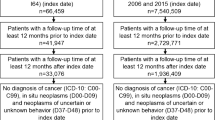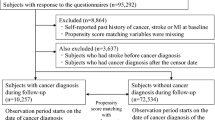Abstract
Background
Etiological factors, such as a malignant disease, in young stroke patients are often neglected. Therefore, in this study, we aimed to investigate the risk of developing cancer in young stroke survivors.
Methods
The current case–control study sample included patients who received an initial ischemic stroke diagnosis documented in the Disease Analyzer database (IQVIA), which compiles data such as risk factors, drug prescriptions, and diagnoses obtained from general practitioners and specialists.
Results
The stroke and non-stroke groups included 18,668 patients each; each group had 2836 (15.3%) participants ≤ 55 years. The cancer incidence in the stroke group over the age of 55 years was higher than in the younger subgroup (29.4% versus 17.3%). The proportions of cancer patients within 10 years of follow-up were higher in the stroke group versus the non-stroke group, as well as in the subgroup of patients aged ≤ 55 versus patients > 55 years (17.3% versus 9.5% and 29.4% versus 24.9%, respectively). The calculated hazard ratio for developing cancer within 10 years of follow-up was higher in the younger stroke population (≤ 55 years) than in the older population (hazard ratio: 1.47 (CI 1.18–1.83) versus 1.17 (CI 1.10–1.25).
Conclusion
In our cohort, young individuals aged ≤ 55 years who suffered a stroke had twice as high risk for developing cancer within 10 years after the index event compared to the control group. Stroke might have implication regarding the subsequent development of cancer and vice versa.


Similar content being viewed by others
References
Aarnio K, Joensuu H, Haapaniemi E, Melkas S, Kaste M, Tatlisumak T et al (2015) Cancer in young adults with ischemic stroke. Stroke 46:1601–1606
Adams HP, Bendixen BH, Kappelle LJ, Biller J, Love BB, Gordon DL et al (1993) Classification of subtype of acute ischemic stroke. Definitions for use in a multicenter clinical trial. TOAST. Trial of Org 10172 in Acute Stroke Treatment. Stroke 24:35–41
Aigner A, Busch MA, Grittner U (2017) Response by Aigner et al to letter regarding article, “Contribution of established stroke risk factors to the burden of stroke in young adults”. Stroke 48:e316
Bergqvist D (2002) Venous thromboembolism in cancer patients: expanding horizons. Semin Thromb Hemost 28(Suppl 3):19–23. https://doi.org/10.1055/s-2002-34071
Blom JW, Doggen CJ, Osanto S, Rosendaal FR (2005) Malignancies, prothrombotic mutations, and the risk of venous thrombosis. JAMA 293:715–722
Caine GJ, Stonelake PS, Lip GY, Kehoe ST (2002) The hypercoagulable state of malignancy: pathogenesis and current debate. Neoplasia 4:465–473
Carrier M, Lazo-Langner A, Shivakumar S, Tagalakis V, Zarychanski R, Solymoss S et al (2015) Screening for occult cancer in unprovoked venous thromboembolism. N Engl J Med 373:697–704
Chen CW, Cheng TJ, Ho CH, Wang JJ, Weng SF, Hou YC et al (2017) Increased risk of brain cancer incidence in stroke patients: a clinical case series, population-based and longitudinal follow-up study. Oncotarget 8:108989–108999
Cocho D, Gendre J, Boltes A, Espinosa J, Ricciardi AC, Pons J et al (2015) Predictors of occult cancer in acute ischemic stroke patients. J Stroke Cerebrovasc Dis 24:1324–1328
Dearborn JL, Urrutia VC, Zeiler SR (2014) Stroke and cancer- A complicated relationship. J Neurol Transl Neurosci 2:1039
Donati MB (1995) Cancer and thrombosis: from Phlegmasia alba dolens to transgenic mice. Thromb Haemost 74:278–281
Edwards RL, Rickles FR, Moritz TE, Henderson WG, Zacharski LR, Forman WB et al (1987) Abnormalities of blood coagulation tests in patients with cancer. Am J Clin Pathol 88:596–602
Falanga A (2005) Thrombophilia in cancer. Semin Thromb Hemost 31:104–110
Falanga A, Rickles FR (1999) Pathophysiology of the thrombophilic state in the cancer patient. Semin Thromb Hemost 25:173–182
Jacob L, Kostev K (2019) Cancer risk in stroke survivors followed for up to 10 years in general practices in Germany. J Cancer Res Clin Oncol 145:1013–1020
Kozera-Strzelinska D, Karlinski M, Rak G, Wojdacz M, Sienkiewicz-Jarosz H, Kurkowska-Jastrzebska I (2019) Stroke and TIA mimics in patients referred to a neurological emergency department by non-ambulance physicians, ambulance physicians and paramedics. Neurol Neurochir Polska 53:83–89
Liberman AL, Prabhakaran S (2017) Stroke chameleons and stroke mimics in the emergency department. Curr Neurol Neurosci Rep 17:15–0727
Mulder FI, Candeloro M, Kamphuisen PW, Bossuyt PM, Guman N, Smit K et al (2019) The Khorana score for prediction of venous thromboembolism in cancer patients: a systematic review and meta-analysis. Haematologica. https://doi.org/10.3324/haematol.2018.209114
Navi BB, Reiner AS, Kamel H, Iadecola C, Elkind MS, Panageas KS et al (2015) Association between incident cancer and subsequent stroke. Ann Neurol 77:291–300
Navi BB, Reiner AS, Kamel H, Iadecola C, Okin PM, Elkind MS et al (2017) Risk of arterial thromboembolism in patients with cancer. J Am Coll Cardiol 70:926–938
Navi BB, Reiner AS, Kamel H, Iadecola C, Okin PM, Tagawa ST et al (2019) Arterial thromboembolic events preceding the diagnosis of cancer in older persons. Blood 133:781–789
Oren O, Herrmann J (2018) Arterial events in cancer patients-the case of acute coronary thrombosis. J Thorac Dis 10:S4367–S4385
Piccioli A, Lensing AW, Prins MH, Falanga A, Scannapieco GL, Ieran M et al (2004) Extensive screening for occult malignant disease in idiopathic venous thromboembolism: a prospective randomized clinical trial. J Thromb Haemost 2:884–889
Prandoni P, Bernardi E, Valle FD, Visona A, Tropeano PF, Bova C (2016) Extensive computed tomography versus limited screening for detection of occult cancer in unprovoked venous thromboembolism: a multicenter, controlled, randomized clinical trial. Semin Thromb Hemost 42:884–890
Putaala J, Yesilot N, Waje-Andreassen U, Pitkaniemi J, Vassilopoulou S, Nardi K et al (2012) Demographic and geographic vascular risk factor differences in European young adults with ischemic stroke: the 15 cities young stroke study. Stroke 43:2624–2630
Quintas S, Rogado J, Gullon P, Pacheco-Barcia V, Garcia-Soto J, Reig-Rosello G et al (2018) Predictors of unknown cancer in patients with ischemic stroke. J Neurooncol 137:551–557
Qureshi AI, Malik AA, Saeed O, Adil MM, Rodriguez GJ, Suri MF (2015) Incident cancer in a cohort of 3,247 cancer diagnosis free ischemic stroke patients. Cerebrovasc Dis 39:262–268
Rathmann W, Bongaerts B, Carius HJ, Kruppert S, Kostev K (2018) Basic characteristics and representativeness of the German disease analyzer database. Int J Clin Pharmacol Ther 56:459–466
Rolfs A, Fazekas F, Grittner U, Dichgans M, Martus P, Holzhausen M et al (2013) Acute cerebrovascular disease in the young: the stroke in young fabry patients study. Stroke 44:340–349
Selvik HA, Thomassen L, Bjerkreim AT, Naess H (2015) Cancer-associated stroke: the Bergen NORSTROKE Study. Cerebrovasc Dis Extra 5:107–113
Tanislav C, Grittner U, Misselwitz B, Jungehuelsing GJ, Enzinger C, von Sarnowksi B et al (2014) Lessons from everyday stroke care for clinical research and vice versa: comparison of a comprehensive and a research population of young stroke patients. BMC Neurol. https://doi.org/10.1186/1471-2377-14-45
Zoller B, Ji J, Sundquist J, Sundquist K (2012) Risk of haemorrhagic and ischaemic stroke in patients with cancer: a nationwide follow-up study from Sweden. Eur J Cancer 48:1875–1883
Funding
No funding was received for this study.
Author information
Authors and Affiliations
Corresponding author
Ethics declarations
Conflict of interest
All authors report to have no conflicts of interest or competing interests related to the current manuscript.
Additional information
Publisher's Note
Springer Nature remains neutral with regard to jurisdictional claims in published maps and institutional affiliations.
Rights and permissions
About this article
Cite this article
Tanislav, C., Adarkwah, C.C., Jakob, L. et al. Increased risk for cancer after stroke at a young age: etiological relevance or incidental finding?. J Cancer Res Clin Oncol 145, 3047–3054 (2019). https://doi.org/10.1007/s00432-019-03022-x
Received:
Accepted:
Published:
Issue Date:
DOI: https://doi.org/10.1007/s00432-019-03022-x




